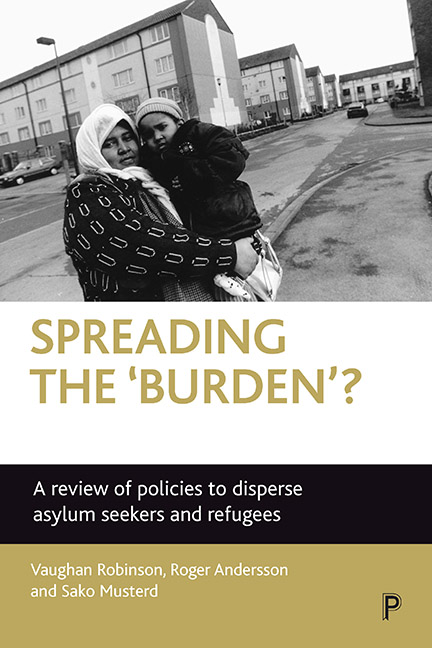Book contents
- Frontmatter
- Contents
- List of tables and figures
- Acknowledgements
- Glossary
- one Introduction
- two Defining the ‘problem’
- three Dispersal policies in the Netherlands
- four Dispersal policies in Sweden
- five Dispersal policies in the UK
- six What works? Improving the efficiency and effectiveness of dispersal
- seven Redefining the ‘problem’ and challenging the assumptions
- References
- Index
- Also available from The Policy Press
one - Introduction
Published online by Cambridge University Press: 20 January 2022
- Frontmatter
- Contents
- List of tables and figures
- Acknowledgements
- Glossary
- one Introduction
- two Defining the ‘problem’
- three Dispersal policies in the Netherlands
- four Dispersal policies in Sweden
- five Dispersal policies in the UK
- six What works? Improving the efficiency and effectiveness of dispersal
- seven Redefining the ‘problem’ and challenging the assumptions
- References
- Index
- Also available from The Policy Press
Summary
This book provides a comparative analysis of European state policies relating to the dispersal of asylum seekers and refugees. The seeds of the project lie in the work of the European Council on Refugees and Exiles (ECRE) Integration Task Force, which was established by the Council of Europe to define, encourage and establish good practice in refugee integration. The task force, by means of its projects and annual conferences, encouraged not only the networking of organisations involved in refugee integration across Europe, but also the definition of good practice through the comparison of national models. It identified key axes of integration, established working groups for each one, and funded many practical projects designed to implement good practice across national boundaries.
Although the task force and its working groups achieved a great deal, inevitably not all axes of integration could be given the same attention. One specific issue that was neglected was the geography of national settlement. Although the work of the task force was inherently spatial (in the sense that it compared different national practice), its focus was on transferring good practice from the national scale to the supra-national scale. This up-scaling meant that the project did not explicitly address ‘space’ as an issue, nor did it consider the subnational scale. Consequently, it ignored the way in which good practice, as such, might be dependent upon – and indeed rooted in – local circumstances. Nor did it consider how good practice might impact differently upon different localities, with their unique histories, demographies and opportunity structures. In other words, in seeking to build a Europe-wide consensus on refugee integration, it failed to consider the geographical context of real and different places, a context in which all the work of the task force had to be set.
Central to such a Europe-wide perspective is a consideration of what types of places refugees and asylum seekers live in. Increasingly, this is being determined by the way in which national governments intervene directly to engineer desired distributions of refugees and asylum seekers across national space.
This volume, and the Council of Europe DGV Home and Justice grant that funded it, address this issue explicitly. This volume does so by:
• providing an account of how and why three EU member states (the Netherlands, Sweden and the UK) have introduced policies to disperse their asylum and refugee populations;
• describing the mechanisms employed to achieve dispersal;
- Type
- Chapter
- Information
- Spreading the 'Burden'?A Review of Policies to Disperse Asylum Seekers and Refugees, pp. 1 - 2Publisher: Bristol University PressPrint publication year: 2003



